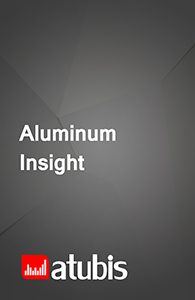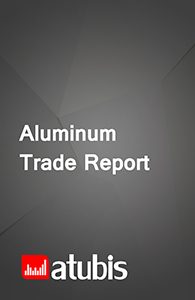Iran’s Aluminum Scrap and Waste Market Outlook Report
9,713€
- TRY: 475,000 ₺
The low energy consumption required for recycling aluminum makes the process important. The energy required to recycle aluminum is about 4-5% of the energy that is needed to produce the light-weight metal from bauxite. Thus, recycling aluminum will result in 95% energy saving. Aluminum scrap and waste fall into two general categories: new and old scrap. New scrap is metal that is left over during the production of finished products or semis. Old scrap, on the other hand, is metal from end-of-life goods. Aluminum scrap can be used by producers with melting capacities, which include producers of secondary unwrought, casting parts, sheets and plates, and wire rod in Iran. A major portion of these products are produced by secondary smelters. Given the importance of scrap and waste, the market is expected to grow over the coming years.
Product Description
With a GDP of $415 billion in 2019, Iran was the third largest economy in the region that year. While the country’s economy was steadily growing after the drop in 2012 due to the sanctions, it dipped once again in 2019 thanks to the return of the sanctions. Although the production of aluminum has a longer history in Iran compared to other countries in the region, it currently stands as the sixth largest producer on a regional scale. Nonetheless, as new aluminum smelters are commissioned in the country, it will definitely advance to the fifth place.
Market drivers of aluminum scrap and waste
As a secondary source of raw material for downstream plants, aluminum scrap is always priced lower than primary aluminum. The lower production costs as a result of the price spread between primary and secondary aluminum make scrap more attractive to producers. The discount of scrap over aluminum is expected to increase as supply grows, leading to higher consumption. Moreover, using scrap from similar products with similar alloy content reduces the need for alloying. This will in turn significantly reduce the consumption of alloying elements. Yet this is true only when using sorted aluminum scrap. Over the recent years, as demand for scrap has grown and the value of scrap has been recognized, collection and sorting have improved.
The most important factor that limits scrap consumption is the impurities that can lead to lower-quality products. This puts pressure on scrap consumption or restricts it to applications where the chemical composition is not crucial. With the increasing demand growth for higher-quality products, demand growth for scrap will be under further pressure.
Overview of Iran’s aluminum scrap and waste market
About a quarter of total aluminum consumption in Iran is sourced from scrap, and that share has increased over the recent years. However, collection rates in the country are still lower than the global average, which is partly due to the fact that end users do not sort their waste and there is not enough stimulus to encourage them to do so. Moreover, scrap is mostly collected in small volumes, putting further pressure on collection rates. But as aluminum prices hit new record highs over the recent years, recycling has gained more attention.
The trade balance of Iran’s aluminum scrap and waste has always been slightly negative, tipped towards net imports. As scrap collection and sorting improved, the trade balance has also improved, but it is expected to remain in negative territory. Iraq has been a major supplier of scrap to Iran’s market, and it is expected to remain the main source of imports over the coming years.
Breakdown of Iran’s aluminum scrap and waste market
Domestic aluminum waste and scrap supply (both new and old, separately) in the forecast timeframe as well as the previous period has been broken down using three factors. The first factor breaks down the market into three categories based on alloy material: commercially pure aluminum, heat-treatable alloys, and non-heat-treatable alloys. Past and future trends for each type of material have been analyzed. Heat-treatable scrap holds the largest share of the market. In the second breakdown, products are distinguished based on product type: lithographic sheet, used beverage cans, wires and cables, radiators, extrusions, pots and pans, engine pistons, other cast auto parts, tiles and dampa, boring and turning, and other products. The domestic aluminum waste and scrap market has also been broken down into soft and hard scrap over the timeframe; hard scrap holds the main share of the market. Finally, using the third factor, aluminum scrap is categorized based on the type of consumers. Secondary smelters are the largest consumers of aluminum scrap.
Additional Information
| Industry | Aluminium Scrap |
|---|---|
| Region | Iran |
| Report Type | Industry Report |
Specifications
| Report Attribute | Details |
| The base year for estimation | 2022 |
| Historical data | 2012-2021 |
| Forecast period | 2022-2027 |
| Quantitative units | Value in USD and Volume in Tonne |
| Report coverage | Market Overview, Dynamics, Market Outlook, Risks to Forecast, Consumer Market, Industry Overview, Market Landscape, Competitive Landscape, Market Attractiveness, External Macro Environment Analysis |
| Segments covered | Source, Composition, Type, Application |
| Pricing and purchase options | Please explore our purchase options to meet your exact research needs. |
Reasons to Buy
- Recognize the geographical distribution of import demand
- Identify the current and future key players of the trading market
- Achieve a better insight on potential target markets
- Understand the behavior of major suppliers/customers either globally or regionally
- Identify competitors as a feed for market analysis
Table of Content
- Executive summary
- Introduction
- Objective
- Market under study
- Supply Market
- Specifications
- Consumption structure
- Applications
- Physical properties
- Subjects discussed
- Geographical scope under study
- Study timeframe
- Study currency
- Potential audience
- Market dynamics
- Market drivers
- Restraints
- Opportunities
- Challenges
- Market overview
- Market size
- Supply
- Supply trends
- Efficiency rates
- Consumption
- Consumption trend
- Consumption Share of domestic product
- Trade
- Exports
- Imports
- Trade balance
- Market balance
- Market breakdown by application
- Inventory
- Supplier inventory
- Consumers inventory
- Market outlook
- Market factors
- Costs and prices
- Competition
- The government
- Other factors
- Future scenarios
- Risks to forecast
- Market factors
- Consumer markets
- Direct consumer markets
- Capacity of Consumer Market
- Consumer Market Operation
- Trade of Consumer Market Products
- Consumer Market Factors
- Forecast of Consumer Market
- Direct consumer markets
- Export potentials
- Destinations
- Trade and insurance costs
- Import market suppliers
- Producers potential share
- Destinations
- Available EOL Scrap
- Market landscape
- Domestic sales markets
- Pricing in the domestic market
- Potential domestic demand
- Trade agreements for imports
- Foreign suppliers
- Foreign sales market
- Prices
- Potential markets overview
- Trade agreements for exports
- Foreign customers
- Domestic sales markets
- Competitive landscape
- Consumers
- Company profile
- Revenue structure
- Gross profit margins
- Capacity, Supply and sales
- Consumers
- Market attractiveness
- Industry rivalry
- Threat of new entrants
- Threat of substitutes
- Bargaining power of buyers
- Bargaining power of suppliers
- Conclusion of Porter analysis
- PESTEL analysis
- Political factors
- Economic factors
- Social factors
- Technology factors
- Environmental factors
- Legal factors
- SWOT analysis
- Short-term strategies
- Long-term strategies
List of Figures
- Supply and consumption; 2012-2021
- Market share of product applications; 2021
- Market surplus; 2021-2027
- Process flowchart
- Market size; 2012-2027
- Amount of supply; 2012-2027
- Efficiency rate; 2012-2027
- Amount of consumption; 2012-2027
- Consumption share of domestic product; 2012-2027
- Exports of product; 2012-2021
- Imports of product; 2012-2021
- Historical trade balance; 2012-2021
- Future Market balance; 2021-2027
- Market consumption breakdown by application; 2012-2027
- Inventories of suppliers; 2012-2021
- Consumers’ inventory of product; 2012-2021
- Production forecast, according to supply and sales analysis; 2021-2027
- Market surplus; 2021-2027
- The share of end-user industries in the consumption; 2012 and 2021
- Changes in the end-consumption of products; 2021 vs 2027
- Capacity distribution structure of direct consumers; 2021
- Existing capacities of direct consumers in each province; 2021
- Suppliers of the export potential destination; 2021
- Historical exports to the export potential destination and future potential; 2016-2027
- Sales channels
- Realized price of the product in the market; 2012-2027
- Potential demand of each province; 2021
- The main foreign suppliers to the market; 2012-2021
- FOB price vs domestic market; 2012-2027
- Map of global major importers > 20,000t; 2021
- Major foreign customers; 2012-2021
- Revenue structure of the consumers; FY2021
- Sales income and gross profit margin of the consumers; FY2012-2021
- Supply and sales of the consumers; FY2012-2021
- SWOT matrix
- Strategies positioning



